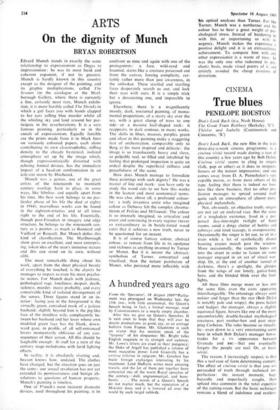ARTS On the dignity of Munch
BRYAN ROBERTSON
Edvard Munch stands in exactly the same relationship to expressionism as Degas to impressionism: he was its most lucid and coherent exponent, if not its greatest. Munch is hardly known in this country except as the designer of the painting, and its graphic multiplications, called The Scream (in the catalogue at the Marl- borough Gallery, where there is currently a fine, certainly most rare, Munch exhibi- tion, it is more harshly called The Shriek) in which a girl faces you with hands clapped to her ears yelling blue murder whilst all the whirling sky and land around her par- ticipate in the reverberations. It is a very famous painting, particularly so in the annals of expressionism. Equally forcible are the prints made from it in black lines on variously coloured papers, each alone contributing its own claustrophobic, stifling density to the already hysterical, isolated atmosphere set up by the image which, though expressionistically distorted with echoing formal devices, has the immediate impact of a head-on confrontation in an icily-cut movie by Hitchcock.
Munch was a genius, one of the great artists of the nineteenth to twentieth century overlap; hard to place, in some ways, like Sibelius. and equally apart from his time. His best work belongs to no par- ticular phase of his life (he died at eighty in 1944); marvellous works can be found in the eighteen-nineties and at all times right to the end of his life. Essentially, though post-Freudian in imagery and edgy structure, he belongs to the nineteenth cen- tury as a painter, as much as Bonnard and Vuillard or Rouault. But Munch defies this kind of classification. The Marlborough show gives an excellent, and most enterpris- ing, token idea of the man's immense stature and this can stand on its own, without alibi.
The most remarkable thing about his work, apart from the sheer physical beauty of everything he touched, is the dignity he manages to impart to even his most psycho- tic scenes. For Munch deals with jealousy, pathological rage, loneliness, despair, death, sickness, murder, incest probably, and every conceivable kind of isolated derangement of the senses. Three figures stand in an in- terior: facing you in the foreground is the virtually green, convulsed mask of a jealous husband; slightly beyond him is the pig-like face of the mindless wife, complacently be- tween her husband and her lover whose own modified green face has the blank, down- ward gaze, in profile, of all self-entranced lovers momentarily oblivious of any con- sequences of their action. All this should be laughable enough: fit stuff for a turn of the century stage melodrama with lurid lighting effects.
In reality, it is absolutely riveting and, heaven knows how, undated. The clothes have changed, but the situation goes on just the same: our sexual revolution has not yet extended its permissiveness and benign ab- solutions to questions of human property. Munch's painting is timeless.
One of Munch's most insistent dramatic devices, used throughout his painting, is to confront us time and again with one of the protagonists: a face, wild-eyed and haunted, stares like a creature possessed out from the canvas, forcing complicity, cer- tainly rather more than just awareness, in the onlooker. These startled and startling faces desperately search us out, and lock their eyes with ours. It is a simple trick but a devastating one, and impossible to ignore.
Elsewhere, there is a magnificently moody, dark, nocturnal painting, of monu- mental proportions, of a starry sky over the sea, with a great clump of trees to one side—or a massive loaf-shaped rock: it reappears, in dark contour, in many works. The shifts in blues, mauves, purples, green and silver in this painting make a staggering feat of orchestration, comparable only to Berg at his most inspired and delicate: the image is so translucently heavy and there, so palpably real, so filled and inhabited by feeling that prolonged inspection is quite an ordeal despite the superficial stillness and peacefulness of the scene.
How does Munch manage to formulate these paintings with such dignity? He was a master of line and mark: you have only to study the wood cuts to see how this works in the leanest and most economical terms. He was also, above all, a profound colour- ist: a truly inventive artist who imagined colour as Debussy felt the complex chroma- ticism of Pefleas and Milisande. The colour is so intensely imagined, so articulate and exact and convincing in every register (never so extraordinary as in barely-tinted wood cuts) that it achieves a new truth, never to be questioned for an instant.
It is of course fantasy colour, abstract colour, as remote from life in its opulence and richness as anything invented by Turner or Monet. But it is nearer the abstract- symbolism of Turner, conceptual and ritualised, than the nature pantheism of Monet, who persisted more inflexibly with
his optical analyses than Turner. For like Turner, Munch was a northerner and his colour has to bear a great weight of psy. chological stress. Instead of burdening us with this, or importuning us with its urgency, Munch makes the experience a positive delight and it is an extraordinary achievement. To compare him with any other expressionist is a waste of time: he was the only one who redeemed its psy- chotic basis, made visual poetry of it. and entirely avoided the cheap evasions of distortion.


































 Previous page
Previous page